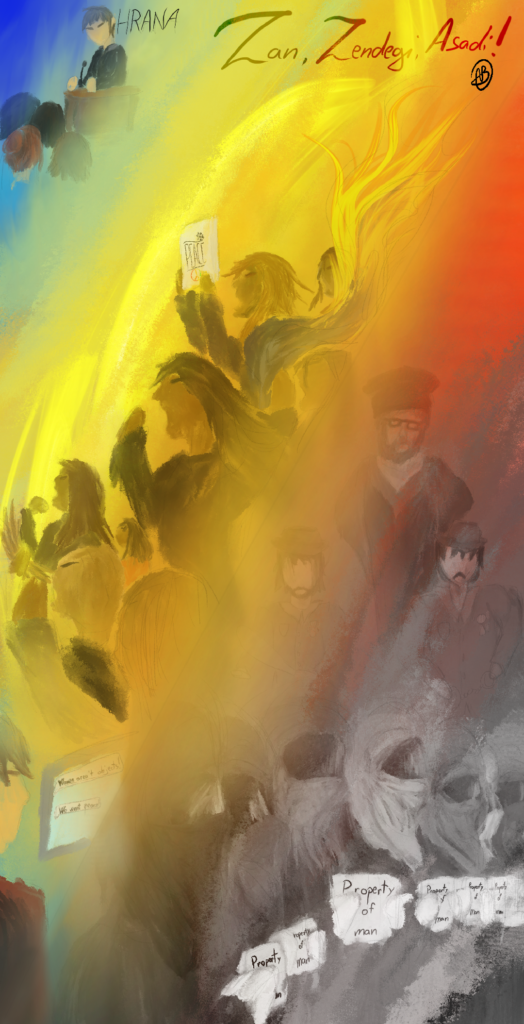By Julia Dec
Edited by Aimée Dhonte
Mahsa
On the thirteenth of September, a young woman from north-western Iran comes to visit her relatives in Iran’s capital – Teheran. The woman in question (Mahsa Amini) is wearing a headscarf – maybe a little looser than others in Teheran. Amini gets off the metro and is stopped by the Guidance Patrol (Iranian vice police). The officers accuse her of improper clothing: a loose scarf sliding off her head – her jeans, too tight.
Mahsa is put into a van, and versions of the subsequent event wander off. According to officials, Amini arrives at the police station, where she is given an hour-long lecture on the virtues of women in Islam – a “standard” procedure.
There, however, she faints and falls into a coma – followed by assisting police officers, driving her to the hospital. The young woman’s family and several witnesses, however, tell a different story.
Prior to this incident, Mahsa was completely healthy. However, under further examination, a supposed brain hematoma, (which was later detected and confirmed) was the result of the severe beating she was put through by the police. They had banged her head against the fender of the van several times.
On the sixteenth of September, Mahsa passes away, not waking up from her coma.

The Birth of a Rebellion
For the next two weeks, riots break out in major cities. At first, people demand those responsible for Mahsa’s death be punished – but in the face of ever more brutal attempts to suppress the protests and silence of the authorities, the young rebels gain momentum.
For the past several weeks, the world has been witnessing the incredible courage of women in Iran: the brutal killing of Mahsa Amini sparked massive protests against the regime of the ultra-conservative Islamic clergy (ayatollahs), who compulsively control women’s bodies, minds, and lives.
Journalists are arrested, telephone networks are jammed, and internet is censored in a desperate desire to control the narrative and conceal the government’s atrocities. Despite this, the women in Iran are not yielding. Persian, Azerbaijani, and Kurdish women (many of them very young) are paying with their lives for freedom.
A Right to Self-determination
Women on the streets of Iran have been fighting not only for the memory of murdered girls, but also for the right to self-determination.
Their slogan is: “Zan, Zendegi, Azadi” – “Women, Life, Freedom”.
As from the time I am writing this article (26/10/2022), at least 250 people have been killed in protests across the country: ~ thirty-two of them children. HRANA – the Iranian Human Rights Organization- estimates at least 12,500 protesters have been imprisoned.
Since the beginning of riots, in sign of civil disobedience, many young women are ostentatiously removing (even burning) their headscarves in public. In Iran, the “hijab and chastity” law requires all girls and women aged 9 and above to cover their hair and necks. This became compulsory in 1981, two years after the Iranian Islamic Revolution. Since then, the requirement of wearing hijab is regarded by many as a symbol of the state’s repression against women. Authorities argue that it is immoral for women to show their hair and necks, and as such, this part of women’s bodies should be veiled.
Videos of Iranian women cutting their hair have flooded the Internet – some do it subtly, strand by strand. Others, shaving almost to the skin – regardless, one senses anger and determination for freedom in their eyes. They do it out of pain, out of a sense of helplessness in the face of what surrounds them, but also, to mark their right to determine their own choices about their bodies, appearances, and self-expression.
These protests united almost the entirety of Iranian society – struck by the unity of different generations, grandparents protesting hand in hand with their granddaughters are spotted. Young people lead the way, with elders following them.
Why should we care?
How, or why are we impacted by a rebellion taking place over 5,000 kilometres away from us? Certainly, there is not much we can do to directly help Iranian girls fight for their most fundamental rights.
Yet even our moral support would be priceless. Iranian women should know they are not alone – that people from all over the world have them deep in their hearts.
Even if protests are not immediately victorious, it is certain that their courage and perseverance will eventually change the world, one step at a time.
Finally, we should also remind ourselves how incredibly privileged are we, living in Europe, in Luxembourg – a developed country, which cares about basic human and women’s rights.
We all should realize that our fundamental freedoms which we breathe, live, casually disregard and are fortunate to have every day, are only but a dream for others.
